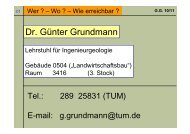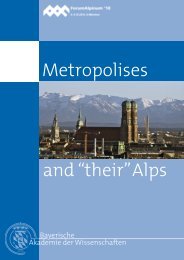The 1806 Goldau landslide event—analysis of a large rock slide
The 1806 Goldau landslide event—analysis of a large rock slide
The 1806 Goldau landslide event—analysis of a large rock slide
You also want an ePaper? Increase the reach of your titles
YUMPU automatically turns print PDFs into web optimized ePapers that Google loves.
the saddle and watershed between the lakes <strong>of</strong> Zug and Lauerz. <strong>The</strong> <strong>slide</strong> <strong>of</strong> Röthen with<br />
a presumed volume <strong>of</strong> at least 20 million m 3 has been dated with the year 1222 after historic<br />
sources (Plane 2), though the upper scarp is not well conserved.<br />
Smaller events like the <strong>rock</strong> fall in 1970 from the eastern scarp or the <strong>rock</strong> <strong>slide</strong> on<br />
October 15th, 2002 (Plane 4) show the constant activity in this area. <strong>The</strong> youngest event at<br />
the moment is the 2005 <strong>rock</strong> <strong>slide</strong>—debris flow <strong>of</strong> Gribsch (5), occurring after heavy precipitation<br />
on August 22nd, 2005. Also, parallel to the eastern scarp numerous open joints and<br />
cracks clearly loom the next possible event (6).<br />
2.4 Failure mechanism<br />
Weathering in the marlstones clearly leads to decalcification to a clayey-silty soil with high<br />
porosity (Figure 9 right diagram). Applying the international standard <strong>of</strong> weathering grades,<br />
the weathering pr<strong>of</strong>ile <strong>of</strong> the marlstone comprises the grades between fresh <strong>rock</strong> and residual<br />
soil (Figure 9 left pr<strong>of</strong>ile). Along with increasing porosity and decreasing material strength,<br />
cohesion and friction <strong>of</strong> the friable <strong>rock</strong> were lowered (Figure 10) significantly in direct shear<br />
box tests in the laboratory.<br />
Figure 9 and 10 indicate, that the calcite content drops only about 5% during weathering<br />
grades I (fresh) to IV (highly weathered). Nevertheless the friction angle decreases from 37° to<br />
23° and cohesion from nearly 60 kPa to 26 kPa in the same weathering range. <strong>The</strong> slope angle<br />
Figure 9. Left: Weathering pr<strong>of</strong>ile <strong>of</strong> the marlstones with classification <strong>of</strong> weathering grades and critical<br />
or possible shear horizon. Right: Decreasing calcite content with increasing weathering grade.<br />
Figure 10. Decrease <strong>of</strong> soil properties with increasing weathering grade. Left friction angle, right cohesion.<br />
Both parameters derived from direct shear box tests in the laboratory.<br />
3698















